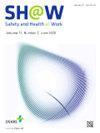消防员社会支持与抑郁症状的关系:消极应对的中介作用
IF 3.5
3区 医学
Q1 PUBLIC, ENVIRONMENTAL & OCCUPATIONAL HEALTH
引用次数: 0
摘要
背景:抑郁症状(DS)会损害身心健康;社会支持被认为是退行性障碍的缓冲和提高应对和恢复能力的促进剂。然而,关于负性应对(NC)在消防人员的安全行为和安全行为中的中介作用的研究几乎没有。方法对重庆市消防人员进行横断面调查,并于2020年通过微信平台发放问卷,收集407名消防人员的有效数据。使用SPSS (Statistical Product and Service Solutions) 26.0进行描述性统计和相关性分析。采用结构方程模型分析SS、NC和DS之间的相关性。并对中介效应进行了评价。结果消防队员对退行性痴呆的检出率为23.3%,接受退行性痴呆的次数越多,发生退行性痴呆的可能性越小。NC与DS呈正相关(β = 0.54, p <;此外,结构方程模型的结果表明,NC部分中介了SS和DS之间的关系(标准误差= 0.039,间接效应= 0.109,95%置信区间:0.047-0.200 p <;0.001)。结论nc在消防队员的SS和DS之间有部分间接影响。SS不仅能直接影响DS,还能通过影响NC间接对DS做功。这一发现将是消防员人口研究中一个新颖而有意义的部分。本文章由计算机程序翻译,如有差异,请以英文原文为准。
Association Between Social Support, and Depressive Symptoms Among Firefighters: The Mediating Role of Negative Coping
Background
Depressive symptoms (DS) can erode physical and mental health; social support (SS) is considered a buffer for DS and a promoter for improving coping and recovery abilities. However, there is almost no research on the mediating role of negative coping (NC) in SS and DS, especially among firefighters.
Methods
A cross-sectional survey was conducted among firefighters in Chongqing, China, and the valid data of 407 firefighters were collected through questionnaires distributed on the WeChat platform in 2020. Statistical Product and Service Solutions (SPSS) 26.0 is used for descriptive statistics and correlation analysis. Structural equation modeling was adopted to analyze the association among SS, NC, and DS. The mediation effect is also evaluated.
Results
Firefighters' detection rate of DS is 23.3%, and when they receive more SS were less likely to develop DS. NC was positively correlated with DS (β = 0.54, p < 0.001) after controlling for SS. Besides, the results of structural equation modeling showed that NC partially mediates the relationship between SS and DS (standard error = 0.039, indirect effects = 0.109, 95% confidence interval: 0.047–0.200 p < 0.001).
Conclusion
NC has a partial indirect effect between SS and DS among firefighters. SS could not only affect DS directly but also indirect work on it by affecting NC. This discovery will be a novel and meaningful part of the research on the firefighter population.
求助全文
通过发布文献求助,成功后即可免费获取论文全文。
去求助
来源期刊

Safety and Health at Work
Social Sciences-Safety Research
CiteScore
6.40
自引率
5.70%
发文量
1080
审稿时长
38 days
期刊介绍:
Safety and Health at Work (SH@W) is an international, peer-reviewed, interdisciplinary journal published quarterly in English beginning in 2010. The journal is aimed at providing grounds for the exchange of ideas and data developed through research experience in the broad field of occupational health and safety. Articles may deal with scientific research to improve workers'' health and safety by eliminating occupational accidents and diseases, pursuing a better working life, and creating a safe and comfortable working environment. The journal focuses primarily on original articles across the whole scope of occupational health and safety, but also welcomes up-to-date review papers and short communications and commentaries on urgent issues and case studies on unique epidemiological survey, methods of accident investigation, and analysis. High priority will be given to articles on occupational epidemiology, medicine, hygiene, toxicology, nursing and health services, work safety, ergonomics, work organization, engineering of safety (mechanical, electrical, chemical, and construction), safety management and policy, and studies related to economic evaluation and its social policy and organizational aspects. Its abbreviated title is Saf Health Work.
 求助内容:
求助内容: 应助结果提醒方式:
应助结果提醒方式:


